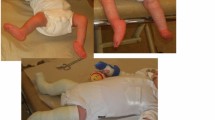Summary
The authors report about 47 patients — 30 boys and 17 girls — suffering on epiphyseolysis (-listhesis) capitis femoris. Particularly comment is given to aetiological problems by laying stress on anamnese, clinical signs of maturity and specially to sceleton-age and the 17 Ketosteroid-secretion. The evaluation resulted by some patients a correlation of physical development only, sceleton-age and secretion of hormons, neither there were only 7 children phaenotypically obvious.
Résumé
Les auteurs informent de 47 clients, 30 garçons et 17 filles, avec une épiphyséolyse (-listhesis) capitis femoris. Speciellement on se prononce avec des problèmes aetiologiques à l'occasion de quoi on a apris des considèrations à côté de l'anamnèse, aux signes cliniques de la maturitée, à l'age squelettique et à la sécretion des 17-Ketosteroides. De plus l'exploration se rendrait seulement physique, de l'age squelettique et de la secrétion hormonelle bien que seulement 7 enfants étaient phaenotypique sans se faire remarquer.
Zusammenfassung
Die Autoren berichten über 47 Patienten — 30 Knaben und 17 Mädchen — mit Epiphyseolysis (-listhesis) capitis femoris. Speziell wird zu ätiologischen Fragen Stellung genommen, wobei u. a. neben Anamnese, klinischen Reifezeichen vor allem dem Skeletalter und der 17-Ketosteroidausscheidung besondere Beachtung geschenkt werden. Dabei ergab die Auswertung nur bei wenigen Patienten eine Korrelation von körperlicher Entwicklung, Skelet- und Lebensalter und Hormonausscheidung, obwohl nur 7 Kinder phänotypisch unauffällig waren.
Similar content being viewed by others
Literatur
Bergstrand, C. G.: The influence of testosterone propionate on skeletal development in the immature rabbit. Acta endocr. (Kbh.) 4, 91 (1950).
Boumann, F. G.: The pathogenesis of epiphysiolysis capitis femoris. Arch. chir. neerl. 15, 122–138 (1963).
Boyd, H. B., A. J. Ingrimm, and H. O. Bourkard: The treatment of slipped femoral epiphysis. Sth. med. J. (Bgham, Ala.) 42, 551 (1949).
Bourrows, H. J.: Slipped upper femoral epiphyses. J. Bone Jt Surg. 39-B, 641–658 (1957).
Debrunner, H.: Über Perandrenwirkung bei der Epiphyseolyse des Oberschenkelkopfes (Coxa vara adolescentium). Ther. Umsch. 2, 223–225 (1946).
Ehrengut, W.: Über hormonelle Dysregulationen bei Epiphysiolysis femoris. Zugleich ein Beitrag zu Problemen des Wachstums. Klin. Wschr. 32, 990–998 (1954).
Ferguson, A. B., and M. B. Howorth: Slipping of the upper femoral epiphysis. J. Amer. med. Ass. 97, 1867 (1931).
Gardemin, H.: Coxa vara adoleszentium und innere Sekretion. Verh. dtsch. orthop. Ges. 29, 144 (1934).
Geigy: Wissenschaftliche Tabellen, 7. Auflage, 1968.
Greulich, W. W., and S. J. Pyle: Radiographic atlas of skeletal development of the hand and wrist. Paolo Alto (Calif.): Stanford University Press 1959.
Guérin, R.: Decollement épiphysaire de l'extrémité inférièure du fémur chez un enfant de 2 ans au cours d'une maladie de Barlow. Rev. Orthop. 35, 239 (1949).
Hamburger, Ch.: Normal urinary excretion of neutral 17-ketosteroids with special reference to age and sex variations. Acta endocr. (Kbh.) 1, 19–37 (1948).
Harris, W. R.: The endocrine basis for slipping of the upper femoral epiphysis. J. Bone Jt Surg. 32-B, 5–11 (1950).
Kaiser, E., W. Rindt, K. H. Conrad u. W. Zimmermann: Normalausscheidung von 17-Ketosteroiden im Harn beim Menschen. Acta endocr. (Kbh.) 47, 285–292 (1964).
Lauber, H. J., u. A. Rein: Beitrag zur Pathogenese der Epiphysiolysis capitis femoris. Dtsch. Z. Chir. 257, 396–406 (1943).
Matthiass, H. H.: Körperbau und Reifung bei Epiphysiolysis capitis femoris. Verh. dtsch. orthop. Ges. 49, 236–240 (1962).
Mégevand, A., u. P. Scholder-Hegi: Das klinische Bild der Epiphysiolysis capitis femoris. Acta rheumatologica Geigy 21, 63–84 (1964).
Nathanson, I. T., L. E. Towne, and J. C. Aub: Normal excretion of sex hormones in childhood. Endocrinology 28, 851–865 (1941).
Ponseti, J. V., and R. McClintock: The pathology of slipping of the upper femoral epiphysis. J. Bone Jt Surg. 38-A, 71–83 (1956).
Reichelt, A.: Der Einfluß des Äthionins auf die enchondrale Ossifikation der Ratte. Frankfurt. Z. Path. 76, 41–51 (1966).
—— Eiweißbedingte Störungen der enchondralen Ossifikation der Ratte. Verh. dtsch. orthop. Ges. 53, 129–132 (1966).
Rüther, H.: Ursachen und Behandlung der jugendlichen Hüftkopflösung. Z. Orthop. Suppl. 84 (1954).
Schmidt-Voigt, J.: Brustdrüsenschwellungen bei männlichen Jugendlichen des Pubertätsalters (Pubertätsmakromastie). Z. Kinderheilk. 62, 590–606 (1941).
Schöffling: zit. bei H. H. Matthiass.
Schonfeld, W. A., and G. W. Beebe: Normal growth and variation in the male genitalia from birth to maturity. J. Urol. (Baltimore) 48, 759–777 (1942).
—— Primary and secondary sexual characteristics. Amer. J. Dis. Child. 65, 535–549 (1943).
Schwenk, A.: Zur Endokrinologie der Pubertät und Präpubertät. II. Mittlg. Z. Kinderheilk. 83, 102–128 (1959).
Schwenk, A.: Physiologie der Pubertät. Hippokrates (Stuttg.) 34, 549–556 (1963).
Scott, J. C.: Displacement of the epiphysis of femur. In: H. Platt (Ed.): Modern trends in orthopedics, 2. Serie. London: Butterworths 1956.
Ströder, J., H. Zeisel u. E. Kölitz: Die Harnausscheidung an Corticoiden und 17-Ketosteroiden während des Kindesalters. Klin. Wschr. 30, 980–982 (1952).
Taillard, W.: Die hormonelle Grundlage der Epiphysenlösung. Verh. dtsch. orthop. Ges. 49, 219–228 (1962).
—— Anatomie und Physiopathologie der Epiphysiolysis capitis femoris. Acta rheumatologica Geigy 21, 15–60 (1964).
Tanner, J. M.: Wachstum und Reifung des Menschen. Stuttgart: Thieme 1962.
Wolff, O. H.: Obesity in childhood. Quart. J. Med. 24, 109–123 (1955).
Zimmermann, W.: Die 17-Ketosteroide, ihre Bedeutung und die Methodik ihrer Bestimmung. Dtsch. med. Wschr. 76, 1363–1367 (1951).
Author information
Authors and Affiliations
Rights and permissions
About this article
Cite this article
Reichelt, A., Rütt, A. Untersuchungen zur Ätiologie der Epiphysiolysis bzw. Epiphysiolisthesis capitis femoris. Arch orthop Unfall-Chir 67, 28–38 (1969). https://doi.org/10.1007/BF00417137
Received:
Issue Date:
DOI: https://doi.org/10.1007/BF00417137




